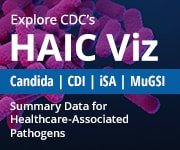HAI Data
Although significant progress has been made in preventing some healthcare-associated infection types, there is much more work to be done. On any given day, about one in 31 hospital patients has at least one healthcare-associated infection.
CDC publishes data reports to help track progress and target areas that need assistance. The data come from two complementary HAI surveillance systems, the National Healthcare Safety Network (NHSN) and the Emerging Infections Program Healthcare-Associated Infections – Community Interface (EIP HAIC).
Please enter the Data Portal below for access to current data reports. The Data Archive contains a complete collection of past HAI data reports.
CDC’s NHSN is the nation’s most widely used HAI tracking system. NHSN provides facilities, states, regions, and the nation with data needed to identify problem areas, measure progress of prevention efforts, and ultimately eliminate HAIs. In addition, NHSN allows healthcare facilities to track antimicrobial use and resistance, blood safety errors and important healthcare process measures such as healthcare personnel influenza vaccine status and infection control adherence rates. A collection of surveillance reports using NHSN data can be found here: https://www.cdc.gov/nhsn/datastat/index.html.
CDC’s annual National and State Healthcare-Associated Infections Progress Report (HAI Progress Report) provides a closer look at the HAIs most commonly reported to CDC’s NHSN. This report describes national and state progress in preventing central line-associated bloodstream infections (CLABSI), catheter-associated urinary tract infections (CAUTI), select surgical site infections (SSI), hospital-onset C. difficile infections, and hospital-onset methicillin-resistant Staphylococcus aureus (MRSA) bacteremia (bloodstream infections). The current HAI Progress Report is accessible via the Data Portal; previous HAI Progress Reports are accessible in the Data Archive.
CDC’s Emerging Infections Programs (EIP) is a national resource utilized for surveillance, prevention, and control of emerging infectious diseases. EIP is a network of state health departments and their collaborators in local health departments, academic institutions, other federal agencies, and public health and clinical laboratories; infection preventionists; and healthcare providers.
The healthcare-associated infections – community interface component of CDC’s EIP engages a network of state health departments and their academic medical center partners to help answer critical questions about emerging HAI threats, advanced infection tracking methods, and antibiotic resistance in the United States. Information gathered through this activity will play a key role in shaping future policies and recommendations targeting HAI prevention
The United States has made significant progress toward our collective goal of eliminating HAIs, and as a result, healthcare in the US is safer now than it was even 10 years ago. Building upon this success and continuing towards the elimination of HAIs is critical.
In 2009, the U.S. Department of Health and Human Services published the National Action Plan to Prevent Health Care-Associated Infections: Road Map to Elimination (HAI Action Plan), which set specific five-year goals for HAI prevention. CDC plays an important role in this plan by producing data that prompt action, leading the country in tracking, preventing and ultimately eliminating HAIs. These data also help pinpoint areas of further improvement that allow for the continued progress.
Additionally, CDC and other federal agencies such as Centers for Medicare and Medicaid Services (CMS), the Agency for Healthcare Research and Quality (AHRQ) and the Office of the Assistant Secretary for Health (OASH) work together to develop tools, recommendations, and programs that offer infection prevention strategies to help protect patients.
The year 2015 marked the start of the new five-year (2015-2020) goals of the HAI Action Plan and a time of important updates and improvements for NHSN. This provided an opportunity to assess prevention progress while strategizing about the best way to move forward as a country.
Additional Information
